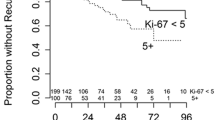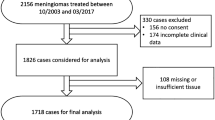Abstract
Patients with high risk of recurrence after meningioma resection might benefit from adjuvant radiation therapy and closer clinical follow-up. While the World Health Organization (WHO) classification and the MIB-1 biomarker are applied in the clinical practice to identify these patients, the reliability of these methods is questionable. To improve the prediction of tumor recurrence, this study evaluated and compared the prognostic usefulness of the biomarker MCM7 with the conventional mitotic index and the MIB-1 biomarker. One hundred sixty patients were retrospectively analyzed. The expression of MIB-1 and MCM7 was determined as proliferative indices (PI—percentage of positive immunoreactive cells among 1000 tumor cells) in tissue microarrays. MCM7 PI revealed significantly higher indices in recurrent meningiomas compared with non-recurrent meningiomas (p = 0.020), while mitotic index and MIB-1 PI did not reach statistical significance (p ≥ 0.547). The optimal cutoff values for recurrence prediction were 3% for MIB-1 PI and 8% for MCM7 PI. MCM7 PI was significantly associated with recurrence-free survival in COX multivariate survival analyses (p = 0.005), while no association was found with mitotic index or MIB-1 (p ≥ 0.153). MCM7 PI allowed for the most accurate prediction of recurrence, obtaining the highest sensitivity and the greatest area under the ROC curve. These results proved that MCM7 PI is a better method for identifying patients with risk of recurrence compared with the traditional methods used in the current clinical practice. MCM7 may thus improve diagnostics, prediction of prognosis and treatment decision making in patients suffering from meningiomas.



Similar content being viewed by others
References
Perry A (2015) Tumours of the meninges. In: Love S, Budka H, Ironside J, Perry A (eds) Greenfield’s neuropathology, 9th edn. CRC Press, Taylor & Francis Group, Boca Raton, pp 1803–1827
Dolecek TA, Propp JM, Stroup NE, Kruchko C (2012) CBTRUS statistical report: primary brain and central nervous system tumors diagnosed in the United States in 2005–2009. Neuro Oncol 14(Suppl 5):v1–v49. doi:10.1093/neuonc/nos218
Perry A (2010) Meningiomas In: Perry A, Brat DJ (eds) Practical surgical neuropathology a diagnostic approach. Churchill Livingstone Elsevier, Philadelphia pp 185–217
Perry A, Stafford SL, Scheithauer BW, Suman VJ, Lohse CM (1997) Meningioma grading: an analysis of histologic parameters. Am J Surg Pathol 21:1455–1465
Perry A, Scheithauer BW, Stafford SL, Lohse CM, Wollan PC (1999) “Malignancy” in meningiomas: a clinicopathologic study of 116 patients, with grading implications. Cancer 85:2046–2056
Perry A, Louis DN, Scheithauer BW, Budka H, von Deimling A (2007) Meningiomas. In: Louis DN, Ohgaki H, Wiestler OD, Cavenee WK (eds) WHO classification of tumours of the central nervous system, 4th edn. IARC, Lyon, pp 164–177
Louis DN, Ohgaki H, Wiestler OD, Cavenee WK, Burger PC, Jouvet A, Scheithauer BW, Kleihues P (2007) The 2007 WHO classification of tumours of the central nervous system. Acta Neuropathol 114:97–109. doi:10.1007/s00401-007-0243-4
Aghi MK, Carter BS, Cosgrove GR, Ojemann RG, Amin-Hanjani S, Martuza RL, Curry WT, Jr., Barker FG, 2nd (2009) Long-term recurrence rates of atypical meningiomas after gross total resection with or without postoperative adjuvant radiation. Neurosurgery 64:56–60. doi:10.1227/01.neu.0000330399.55586.63 (discussion 60)
Domingues PH, Sousa P, Otero A, Goncalves JM, Ruiz L, de Oliveira C, Lopes MC, Orfao A, Tabernero MD (2014) Proposal for a new risk stratification classification for meningioma based on patient age, WHO tumor grade, size, localization, and karyotype. Neuro Oncol 16:735–747. doi:10.1093/neuonc/not325
Olar A, Wani KM, Sulman EP, Mansouri A, Zadeh G, Wilson CD, DeMonte F, Fuller GN, Aldape KD (2015) Mitotic index is an independent predictor of recurrence-free survival in meningioma. Brain Pathol 25:266–275. doi:10.1111/bpa.12174
Fukushima S, Terasaki M, Sakata K, Miyagi N, Kato S, Sugita Y, Shigemori M (2009) Sensitivity and usefulness of anti-phosphohistone-H3 antibody immunostaining for counting mitotic figures in meningioma cases. Brain Tumor Pathol 26:51–57. doi:10.1007/s10014-009-0249-9
Simon M, von Deimling A, Larson JJ, Wellenreuther R, Kaskel P, Waha A, Warnick RE, Tew JM Jr, Menon AG (1995) Allelic losses on chromosomes 14, 10, and 1 in atypical and malignant meningiomas: a genetic model of meningioma progression. Cancer Res 55:4696–4701
Weber RG, Bostrom J, Wolter M, Baudis M, Collins VP, Reifenberger G, Lichter P (1997) Analysis of genomic alterations in benign, atypical, and anaplastic meningiomas: toward a genetic model of meningioma progression. Proc Natl Acad Sci USA 94:14719–14724
Joachim T, Ram Z, Rappaport ZH, Simon M, Schramm J, Wiestler OD, von Deimling A (2001) Comparative analysis of the NF2, TP53, PTEN, KRAS, NRAS and HRAS genes in sporadic and radiation-induced human meningiomas. Int J Cancer 94:218–221
Riemenschneider MJ, Perry A, Reifenberger G (2006) Histological classification and molecular genetics of meningiomas. Lancet Neurol 5:1045–1054. doi:10.1016/s1474-4422(06)70625-1
Fontaine B, Rouleau GA, Seizinger BR, Menon AG, Jewell AF, Martuza RL, Gusella JF (1991) Molecular genetics of neurofibromatosis 2 and related tumors (acoustic neuroma and meningioma). Ann N Y Acad Sci 615:338–343
Leone PE, Bello MJ, de Campos JM, Vaquero J, Sarasa JL, Pestana A, Rey JA (1999) NF2 gene mutations and allelic status of 1p, 14q and 22q in sporadic meningiomas. Oncogene 18:2231–2239. doi:10.1038/sj.onc.1202531
Menon AG, Gusella JF, Seizinger BR (1990) Progress towards the isolation and characterization of the genes causing neurofibromatosis. Cancer Surv 9:689–702
Alahmadi H, Croul SE (2011) Pathology and genetics of meningiomas. Semin Diagn Pathol 28:314–324
Abry E, Thomassen IO, Salvesen OO, Torp SH (2010) The significance of Ki-67/MIB-1 labeling index in human meningiomas: a literature study. Pathol Res Pract 206:810–815. doi:10.1016/j.prp.2010.09.002
Torp SH, Lindboe CF, Granli US, Moen TM, Nordtomme T (2001) Comparative investigation of proliferation markers and their prognostic relevance in human meningiomas. Clin Neuropathol 20:190–195
Hunt DP, Freeman A, Morris LS, Burnet NG, Bird K, Davies TW, Laskey RA, Coleman N (2002) Early recurrence of benign meningioma correlates with expression of mini-chromosome maintenance-2 protein. Br J Neurosurg 16:10–15
Stillman B (1996) Cell cycle control of DNA replication. Science 274:1659–1664
Madine MA, Khoo CY, Mills AD, Laskey RA (1995) MCM3 complex required for cell cycle regulation of DNA replication in vertebrate cells. Nature 375:421–424. doi:10.1038/375421a0
Kearsey SE, Maiorano D, Holmes EC, Todorov IT (1996) The role of MCM proteins in the cell cycle control of genome duplication. Bioessays 18:183–190. doi:10.1002/bies.950180305
Freeman A, Morris LS, Mills AD, Stoeber K, Laskey RA, Williams GH, Coleman N (1999) Minichromosome maintenance proteins as biological markers of dysplasia and malignancy. Clin Cancer Res 5:2121–2132
Saydam O, Senol O, Schaaij-Visser TB, Pham TV, Piersma SR, Stemmer-Rachamimov AO, Wurdinger T, Peerdeman SM, Jimenez CR (2010) Comparative protein profiling reveals minichromosome maintenance (MCM) proteins as novel potential tumor markers for meningiomas. J Proteome Res 9:485–494. doi:10.1021/pr900834h
Gauchotte G, Vigouroux C, Rech F, Battaglia-Hsu SF, Soudant M, Pinelli C, Civit T, Taillandier L, Vignaud JM, Bressenot A (2012) Expression of minichromosome maintenance MCM6 protein in meningiomas is strongly correlated with histologic grade and clinical outcome. Am J Surg Pathol 36:283–291. doi:10.1097/PAS.0b013e318235ee03
Giaginis C, Georgiadou M, Dimakopoulou K, Tsourouflis G, Gatzidou E, Kouraklis G, Theocharis S (2009) Clinical significance of MCM-2 and MCM-5 expression in colon cancer: association with clinicopathological parameters and tumor proliferative capacity. Dig Dis Sci 54:282–291. doi:10.1007/s10620-008-0305-z
Padmanabhan V, Callas P, Philips G, Trainer TD, Beatty BG (2004) DNA replication regulation protein Mcm7 as a marker of proliferation in prostate cancer. J Clin Pathol 57:1057–1062. doi:10.1136/jcp.2004.016436
Gonzalez MA, Pinder SE, Callagy G, Vowler SL, Morris LS, Bird K, Bell JA, Laskey RA, Coleman N (2003) Minichromosome maintenance protein 2 is a strong independent prognostic marker in breast cancer. J Clin Oncol 21:4306–4313. doi:10.1200/jco.2003.04.121
Kikuchi J, Kinoshita I, Shimizu Y, Kikuchi E, Takeda K, Aburatani H, Oizumi S, Konishi J, Kaga K, Matsuno Y, Birrer MJ, Nishimura M, Dosaka-Akita H (2011) Minichromosome maintenance (MCM) protein 4 as a marker for proliferation and its clinical and clinicopathological significance in non-small cell lung cancer. Lung Cancer 72:229–237. doi:10.1016/j.lungcan.2010.08.020
Hanna-Morris A, Badvie S, Cohen P, McCullough T, Andreyev HJ, Allen-Mersh TG (2009) Minichromosome maintenance protein 2 (MCM2) is a stronger discriminator of increased proliferation in mucosa adjacent to colorectal cancer than Ki-67. J Clin Pathol 62:325–330. doi:10.1136/jcp.2007.054643
Helfenstein A, Frahm SO, Krams M, Drescher W, Parwaresch R, Hassenpflug J (2004) Minichromosome maintenance protein (MCM6) in low-grade chondrosarcoma: distinction from enchondroma and identification of progressive tumors. Am J Clin Pathol 122:912–918. doi:10.1309/g638-tknn-g2cj-uxwl
Boyd AS, Shakhtour B, Shyr Y (2008) Minichromosome maintenance protein expression in benign nevi, dysplastic nevi, melanoma, and cutaneous melanoma metastases. J Am Acad Dermatol 58:750–754. doi:10.1016/j.jaad.2007.12.026
Aximu D, Azad A, Ni R, Colgan T, Nanji S (2009) A pilot evaluation of a novel immunohistochemical assay for topoisomerase II-alpha and minichromosome maintenance protein 2 expression (ProEx C) in cervical adenocarcinoma in situ, adenocarcinoma, and benign glandular mimics. Int J Gynecol Pathol 28:114–119. doi:10.1097/PGP.0b013e3181895573
Facoetti A, Ranza E, Grecchi I, Benericetti E, Ceroni M, Morbini P, Nano R (2006) Immunohistochemical evaluation of minichromosome maintenance protein 7 in astrocytoma grading. Anticancer Res 26:3513–3516
Wharton SB, Chan KK, Anderson JR, Stoeber K, Williams GH (2001) Replicative Mcm2 protein as a novel proliferation marker in oligodendrogliomas and its relationship to Ki67 labelling index, histological grade and prognosis. Neuropathol Appl Neurobiol 27:305–313
Backer-Grondahl T, Moen BH, Torp SH (2012) The histopathological spectrum of human meningiomas. Int J Clin Exp Pathol 5:231–242
Fernebro E, Dictor M, Bendahl PO, Ferno M, Nilbert M (2002) Evaluation of the tissue microarray technique for immunohistochemical analysis in rectal cancer. Arch Pathol Lab Med 126:702–705. doi:10.1043/0003-9985(2002)126<0702:eottmt>2.0.co;2
Rubin MA, Dunn R, Strawderman M, Pienta KJ (2002) Tissue microarray sampling strategy for prostate cancer biomarker analysis. Am J Surg Pathol 26:312–319
Engellau J, Akerman M, Anderson H, Domanski HA, Rambech E, Alvegard TA, Nilbert M (2001) Tissue microarray technique in soft tissue sarcoma: immunohistochemical Ki-67 expression in malignant fibrous histiocytoma. Appl Immunohistochem Mol Morphol 9:358–363
Hoos A, Urist MJ, Stojadinovic A, Mastorides S, Dudas ME, Leung DH, Kuo D, Brennan MF, Lewis JJ, Cordon-Cardo C (2001) Validation of tissue microarrays for immunohistochemical profiling of cancer specimens using the example of human fibroblastic tumors. Am J Pathol 158:1245–1251. doi:10.1016/s0002-9440(10)64075-8
Simpson D (1957) The recurrence of intracranial meningiomas after surgical treatment. J Neurol Neurosurg Psychiatry 20:22–39
Labib K, Tercero JA, Diffley JF (2000) Uninterrupted MCM2-7 function required for DNA replication fork progression. Science 288:1643–1647
Stoeber K, Tlsty TD, Happerfield L, Thomas GA, Romanov S, Bobrow L, Williams ED, Williams GH (2001) DNA replication licensing and human cell proliferation. J Cell Sci 114:2027–2041
Schrader C, Janssen D, Klapper W, Siebmann JU, Meusers P, Brittinger G, Kneba M, Tiemann M, Parwaresch R (2005) Minichromosome maintenance protein 6, a proliferation marker superior to Ki-67 and independent predictor of survival in patients with mantle cell lymphoma. Br J Cancer 93:939–945. doi:10.1038/sj.bjc.6602795
Williams GH, Romanowski P, Morris L, Madine M, Mills AD, Stoeber K, Marr J, Laskey RA, Coleman N (1998) Improved cervical smear assessment using antibodies against proteins that regulate DNA replication. Proc Natl Acad Sci USA 95:14932–14937
Acknowledgements
The funding was provided by Norwegian University of Science and Technology.
Funding
No funding to report.
Author information
Authors and Affiliations
Corresponding author
Ethics declarations
Conflict of interest
The authors declare that they have no conflict of interest.
Informed consent
Waiver of consent was given by the Regional Ethics Committee because patients were either deceased or severely disabled.
Rights and permissions
About this article
Cite this article
Winther, T.L., Torp, S.H. MCM7 expression is a promising predictor of recurrence in patients surgically resected for meningiomas . J Neurooncol 131, 575–583 (2017). https://doi.org/10.1007/s11060-016-2329-0
Received:
Accepted:
Published:
Issue Date:
DOI: https://doi.org/10.1007/s11060-016-2329-0




